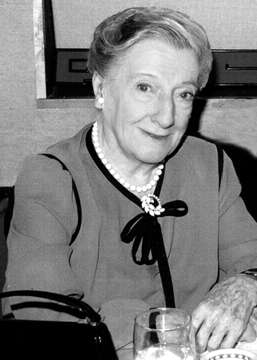
“Remember, dear, you don’t have to judge ‘the ideas’ by the people who believe in them.” Jessmin Howarth“We were blessed in our lives to come close to some special human beings. Special, yes, because they had more being than the rest of us. But that doesn’t mean that they were any the less human. Quite the contrary.” Dushka Howarth
 Jessmin Howarth, 1983
|
These excerpts are taken from It’s Up to Ourselves: A Mother, a Daughter, and Gurdjieff, A Joint Memoir, by Jessmin (Mother) and Dushka (Daughter) Howarth. Copyright © 2003 Dushka Howarth. Scheduled for publication in 2004, the book will include over 700 photographs.
“There is more than one kind of food at my table. Let the food you eat here stay in memory only, but the other kinds of ‘food’ carry with you.” G. I. Gurdjieff
 Gurdjieff’s crowded supply closet … and “private office.”
|
As the years pass, I become increasingly, and painfully, aware of how few of us are still around who actually knew Mr. Gurdjieff, spent time with him, shared meals, or traveled with him. Simple, human aspects of his life are being forgotten, misconstrued, or blown up out of all proportion. Even something as natural and normal as the food he ate or had served to large groups of guests, and its relative importance in his daily routine and his teaching, etc. is being given all kinds of false interpretations—as has his practice of having “toasts to idiots” drunk at mealtimes.
Through the years I had been asked so often by various groups and personal friends to help them in preparing Mr. Gurdjieff’s “Special Salad,” that I originally simply planned to put in a recipe, and leave it at that. But even the “salad” and why it is “special” seemed to call for so much explanation that I ended up wondering if the whole subject of Mr. Gurdjieff in relation to food and drink didn’t merit some discussion and putting in perspective.
Nowadays, especially in most religious or spiritual contexts, actual physical food seems to be considered something one should ideally try to deprive oneself of, certainly not relish. Mr. Gurdjieff, on the other hand, one came to realize, always accorded food, its preparation and distribution the greatest respect. There was nothing hedonistic in this attitude. It came from his esteem for our marvelous human bodies and a belief that we are obligated to provide them with the best possible care and nourishment, including sense impressions! (He only advocated fasting for special people under special circumstances, closely supervised.)
In the early years, first in Russia and then in Europe, though often coping with severe financial set-backs, he always felt required to provide generously for those around him, his family, various followers, and even (especially during the war) complete strangers.
But he insisted: “Man should eat, not as an animal, but consciously.”1
This concept itself is not unique to Gurdjieff, only the importance he accorded it. Almost every religion advocates prayers before meals to remind one of this, but the reason itself has almost been forgotten.
Of all the examples Gurdjieff might have used to illustrate the essential aspect of his teaching, “quality of attention,” he chose the one experience that all human beings share: “When you do a thing, do it with the whole self, one thing at a time. Now I sit here and I eat. For me nothing exists in the world except this food, this table. I eat with the whole attention. So you must do—in everything. To be able to do one thing at a time—this is the property of man, not man in quotation marks.”
At another time he was quoted as saying: “If one knows how to eat properly, one knows how to pray.” And yet again: “It is important to compose a dish in its correctly-blended elements as a composition of music or the colors in painting. Harmony in scale. Must have much knowledge to be a good cook. A culinary doctor.”2
Louise Goepfert March, one of Gurdjieff’s secretaries at the Prieuré, remembered that in those days he was usually quiet at the table. He would say, “When I eat, I self-remember.”3 And he chided people who insisted on talking during the meal, “Idiot God made only one mouth. Should have made two.”4
Thomas de Hartmann also tells us that: “To taste life fully was one of Mr. Gurdjieff’s principles. During our life with him we tried every sort of eastern dish, some very exotic. He told us that in the East they have always paid particular attention to the refinement of food elements. The aim is not to gorge oneself under the table, but rather to sample, in tiny portions, all kinds of variation of taste experiences.”5 “I can still see him vividly, his muscles completely relaxed as always. Slowly he lifts to his mouth a very good pear, not peeled. Unhurried, he takes a bite of it as if striving to absorb its entire aroma, it’s entire taste.”6
 Late lunch with John Pentland in a roadside café, France 1949. This photograph by Dushka Howarth is often cropped and reprinted as the “fez photo.” Copyright © 2003 Dushka Howarth
|
I suppose I was one of the few who dared take snapshots of Mr. G., and I only did it on the trips, (the apartment was too dark in any case). Bill Segal took some nice ones when he came to Paris with his wife, Cora, and their daughters, Liz and Margaret, but most people probably thought it disrespectful. Of course there was no journalistic interest at that time, so there are few good pictures, especially of Mr. G.’s last year. I don’t mean good technically, but which give a truer impression of what he was really like.
I have eight or nine minutes of home movies that Mrs. [Evelyn] Sutta took of us all, also outdoors during the trips. As far as I know, these may constitute the only moving picture record of Mr. Gurdjieff, and show him relaxed, happy to be with a few old friends and a group of youngsters, away from the usual pressures. This is certainly not the ferocious “Master” described in some books, but the much more kindly, humorous old man that many of us remember. So many published writings seem to concentrate egoistically on the author’s personal battles with himself and his teacher, exaggerating the difficulties that had to be overcome in the course of this work. The result is that for many younger people that I talk with, Gurdjieff, as that “Teacher,” has emerged as some kind of ogre. So I cherish these few moments of film which show the other side of Gurdjieff, the man. I am working on having stills made from them to add to the limited pictorial record.
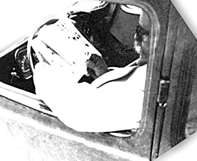
One tiny, hard-to-see snapshot that I would love to see enlarged is of Mr. G. sitting in his beloved Citroen with a magazine open on the steering wheel in front of him. It is a comic book! Probably he was just checking out something little Mary Sinclair (Lord Pentland’s daughter) had brought along on the trip, but I guess I’ll never know!
“Music alone cannot separate the whole of our unconscious automatism, but it is one of the aids to this.” G. I. Gurdjieff, 1923
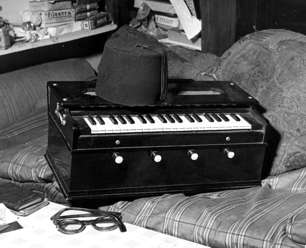 Gurdjieff’s Harmonium
|
Naturally I have always regretted that the recordings I made of Mr. G. in Paris, every day after lunch and dinner, weren’t of better technical quality.
I was an amateur but did my best. We had brought to France three machines, (two Brush tape recorders and one wire one) which were apparently, in 1949, the first magnetic recorders anyone had seen in Europe, so I could find no one who had the experience to service them. I soon gave up on the wire. It would tangle up in a metal ball and couldn’t be rewound or mended. But when even the better of the two tape machines began to have difficulties, I asked around until someone suggested that the Radio Diffusion engineers might be able to repair it.
Putting in an empty tape to be used for testing, I lugged the heavy suitcase-sized recorder to the studios. Several days later I was summoned to pick it up. Various engineers had tried and failed to correct the problems, but one of them had evidently been unable to resist this new toy and had taken it home with him. The test tape was filled with French comments, laughter, a “grandmère’s” story, a toddler’s singing, etc.
I finally diagnosed for myself one of the reasons for the poor quality and fluttering vibrations. The felt pad which presses the tape to the recording head was almost worn through.
Since new empty tapes were taking so long to come from New York, Michel [de Salzmann] had offered to drive me to Brussels, one of the few places in Europe where they might be bought. Someone suggested that the special carpet factories there might provide the extra-fine type of felt I needed.
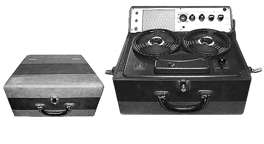
An additional problem was that the apartment at 6 Rue des Colonels Renard, was in a very old building and the rickety elevator rarely worked. But when it did, it drew off so much electricity that my recorder would slow down. So I was never sure when Mr. G. finished playing and asked, as he usually did, to hear it played back, whether there might not be a sudden burst of speeded up tinkling. At this point, of course, all the listeners’ soulfully closed eyes would pop open to glare at me as if I had done it intentionally.
At times, in fact, nothing recorded at all, and while everyone waited I would hurriedly sneak on a tape from another day and pretend it was the playback. Nobody else ever noticed, I don’t think, but I often wondered if Mr. G.’s usual “Bravo, Sophie!”7 wasn’t sometimes ironic.
“His devotion to Sophia is lovely to see—she is Directeur Music and each night before going home has played us some of his music recorded on the “wire.” Often it ends with him exclaiming, ‘Bravo, Sophy—for this I show you genuine forged thousand franc note!’ To which she replies, ‘Oh, that’s all right—I’ve got one too!’”8
I finally left Europe at the end of 1949, joining the Queen Elizabeth in Southampton. Mme. de Salzmann, Lise Tracol, Cynthia Pearce and Bernard LeMaitre were already aboard and I was asked to include in my own baggage the whole collection of recorded tapes packed into a huge foot locker. There was a plan to edit them and make some recordings to sell as part of the funding for the publication of Mr. G.’s books. So on arrival in New York, I guess I wasn’t quite honest when the Customs man asked me if I had anything to declare that wasn’t strictly personal effects, and I answered: “No! Nothing!”
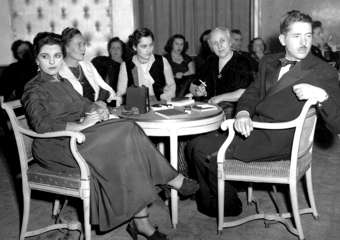 Aboard the Queen Elizabeth sailing to New York, 1949 (Left to right): Dushka Howarth, Cynthia Pearce, Lise Tracol, Mme. de Salzmann and Bernard Le Maitre. Copyright © 2003 Dushka Howarth
|
Then I had a flash of inspiration and tried to put on an injured, stupid, expression and said: “Well, you know … I spent this whole year in Paris studying singing, and I worked very hard but my mother just wouldn’t believe I wasn’t fooling around. So to prove to her that I was seriously working and doing my practicing, every day when I did my vocal exercises I recorded them. Would you like to hear?”
He quickly slammed down the lid and waved me through!
“You sit around waiting for pearls when what you should actually be doing is not to be swine.” Mme. Ouspensky
 Sophie Grigorievna Ouspensky
|
Having felt, every time I came from her room, that whatever Madame said regarding the Work, organization, Mr. Gurdjieff, the house, or even individual people, was of general application and always connected with higher principles, I have decided to write down what and how I remember her conversations.
There exist photographs taken in 1922 at the Dalcroze studio in Paris. One shows Mr. G. sitting near the piano platform with Mme. O. beside him. She said that her thus being “near” to Mr. G. was the result of chance and circumstance … that opportunities to have contacts with a “teacher” do not always come because they are “deserved”—that sometimes one was near Mr. G. for a time, and then another would have that place.
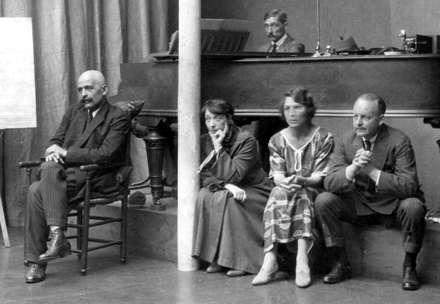 Gurdjieff observing movements in Jessmin Howarth’s Dalcroze studio, Paris 1922. To Gurdjieff’s left are Madame Ouspensky, Catherine and Maurice Nicoll. Alexandre de Salzmann stands behind the piano, and the edge of Thomas de Hartmann’s shoulder and head can be seen as he sits at the piano. Copyright © 2003 Dushka Howarth
|
One of the people who cared for Mme. O. during her last years was Daphne Ripman Matchelajovic, who, now widowed, leads a large, active group in Buenos Aires. She kindly sent me some of the notes she made at Mendham from 1946–1950 that illustrate the kinds of conversations that took place in Mme.’s room while they were choosing readings, discussing people’s questions and reporting on events of the day. Here are some excerpts that I particularly treasure:
Mme. said, “If our aim is not formed, we are not in the work yet. If a man has aim he makes demands on himself—a man in the work knows what he wants, knows right from wrong and is determined to achieve his aim—hates sleep and desires to remember himself and takes everything relative to that.”
Question: If one’s aim is not formed yet and one cannot start work until one knows what one wants, it seems to be a circle. How can one get out?
“It is a vicious circle but a way out does in fact exist. But for very few people. Only for those who realize that they are in a circle—have decision and determination to come out—and are willing to pay a high price to escape. You cannot come to consciousness unconsciously. If we see what we have not got we will know what we want—and what effort or payment we must make to get it.”
We can always gauge how much we want something by the price we are willing to pay for it. Mme. describes us now as “People without railway ticket who come up to the gate but who won’t be let through.”
Question: This house as arranged by Mme. seems to collect attention. If we use this house rightly it would help us to collect ourselves?
In fact, Mme. finds that on the whole we have less attention and are less conscious than people in ordinary life. She says that “today people in ordinary life have to have a certain degree of awareness—business people have to—they know they lose money if they don’t—people in jobs have to be alert or they lose their jobs.” But we in this house can do things with impunity and therefore in fact Mme. finds most of the time we are on a level lower than people in ordinary life.
“Making demands on oneself is not a question of activity. Some machines are made to be active.” To make demands on oneself, try to stop the machine in simple ways, which depends on whether one has energy.
“It should already be clear that you cannot create energy. Necessary save energy, stop wastage. This is possible only if it is your heart’s desire and you know what you want.”
We had been told many times that we could not do. Mme. said, “yes, in happenings, in momentum, impossible to do—only way of doing was by going against happenings, by stopping momentum. Aim is to be free to remember oneself. It is impossible to see anything or do anything without first stopping machine. She saw us as people without brakes. Even with car the first thing you check, before knowing what speed it goes at, are the brakes—while things were going at high speed, like a car going at high speed, no change of direction was possible.”
“Everything depends on whether you really want, or you only think you do. Work is not living in house or coming into special conditions, or reading books, or coming to lectures or listening to readings. None of this leads in direction of work or aim from system point of view. People are divided in two categories—those who think and those who really want. If one really wants, one does.” God gives one free choice. No one forces you to do it. But your choice places you “like the dog and the antelope, one goes for the bones and the other goes to the grass,” (in the anecdote it is carnal or spiritual). And all this has nothing to do with high ideas and imagination about yourself. Until one sees oneself as one is, and it may mean going many steps backwards from what one thought one was, one has no starting point.
By ourselves we do not examine ourselves. We have to be made to see. If we then see—“it is like a thermometer—we can throw away thermometer or refuse to put it in our mouth but it is a fact. What we do with what we see is our business but facts exist, thermometer exists, temperature exists.”
Before it is possible to work on attention a person must know why and what they want—to direct attention towards—because “attention is like a tool, like a knife which can be used for right purpose or wrong purpose.”
Analogy from Buddha reading: “From the same food and the same circumstances the hornet produces poison and the bee produces honey.”
“Directed attention supposes someone there to direct it—not just chariot without driver.”
Where one’s attention is caught, one becomes that thing and of the level of that thing. If one loses one’s attention in this table one becomes this table. Collecting attention is bringing it back and bringing it into a definite place in oneself.
Question: This feeling that one is nothing, to really feel it is a very rare thing.
Mme. answered that “you either have some feeling or have not. And what does it mean, nothingness? We come as beggar and we go as beggar. We have nothing—we have no consciousness, no ‘I,’ no will—are automatons. Question of seeing facts. Question of whether bigger ‘Idea’ exists for one or not. To be humble is natural, to be proud is absurd.”
Realization must grow as man examines himself, observes. Mme. said for her “big idea was that man was self-creative being, that exactly what one is depends on oneself.”
Man has in his nature all things from God to devil. They all have their place and their “note,” only which ones control is the question for us. “Not question of abolishing lower—have pig in oneself … it isn’t a question of killing pig, but keeping it in backyard.”
Mme. also said she didn’t want us to forget the parable of the talents—not to think that God had a sentimental attitude towards us. Those who had something could get more, but those who did not make use of what they had, would lose even what they had got. This was a principle and not sentimental.
“All work begins with the control of attention, and in this connection much can be learned from the Movements.” Mme. Ouspensky
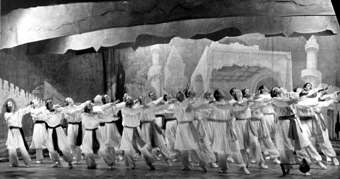 Jessmin Howarth’s Movement’s class during a semi-public demonstration at London’s Colet House, 1939. The participants are members of P. D. Ouspensky’s community in England, “Lyne Place,” classes insisted on by Mme. Ouspensky.
|
Since so many of you are now embarking on the Movements, it seemed appropriate to say something, both about their background or even about the way you do them. I’m told that you are now beginning to study the Movements. How many lessons have you had? Four? Five?
Well! Doesn’t it feel very interesting that Mr. Gurdjieff was not content to just give his system of ideas, but that he also brought a system of “sacred dances,” of “Movements?” And he made it very clear that the study of the ideas and the practice of the Movements were to be complimentary.
And if I think a little, I realize why it must be.
Certainly, when I first hear of the “teaching” I am interested, uplifted, because I know Mr. G.’s aim was to help us develop consciousness; and this gives us a purpose in life. We realize then, as some of his words have brought to us, that it is quite true: We are asleep in certain ways. We don’t really know what we’re doing … what we are thinking … what we are feeling. We are not aware. We don’t live intentionally.
And when we realize that, something wishes to be able to live differently. And we try! We find that we really do need many, many reminders. We do need to wish very deeply and very continuously.
And then it is made possible for us to go into the “Movements.” And there we are under different conditions. We find that our habitual vocabulary of attitudes, movements, and gestures isn’t required. We are asked to take positions and move in ways that many of us have never done before. And so there is a possibility of seeing … of knowing myself.
And as I “work,” I realize that what I need is a very special kind of attention. With my head I try to be clear. In the Movements, my head knows what the next attitude is supposed to be. It tries to help my body to get there directly. My body feels the different positions. It senses how it should be. It knows that it changes the tonicity of its muscles according to the various positions… So it has an attention as well as the head. And in myself I’m eager to do the Movements. I’m eager to learn what they can bring and so there’s also an attention in the feeling.
And when all of these are present … somehow I’m aware of all my energies being used in a right way. I feel myself collected. Somehow, a kind of life force in me is released and I can become more open, more sensitive, and perhaps receive impressions of a finer quality than usual.
Now! One thing I’ll say to you … in the beginning in the Movements you will want to do them very well. And so you should, because these Movements are created in such a way that unless they are done absolutely exactly, the inner connections will not be linked, and the vibration that one looks for will not appear. But! If I grow too identified with how I do the Movements, and think only of executing the Movements very well … ah, then I lose something.
It might be that even if I made a mistake … if I were able, at that very instant, to see myself … not the mistake so much. Not to criticize myself, excuse myself, justify it … but really see how I am at this very instant. It’s the act of seeing at this exact moment … of being aware at the moment one moves. That is what I must try to develop!
What I see … how I do … yes, I learn from that. But if I can try to be alive, and awake at the very instant that I move or speak … then I really am helping myself along the road to growing more conscious.
So try not to forget when you get enthusiastic about your Movements. Try to remember what it is you are really trying for … to develop and make grow.
I hope you all get a great deal from Movements. Most of us have. You’ll find that, somehow, through your body and your feeling you’ll begin to understand things in the system of ideas that might otherwise remain, perhaps, only theory.
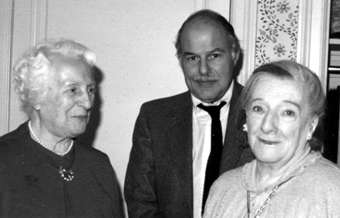 Mme. de Salzmann, Michel de Salzmann, & Jessmin Howarth
|
1 Our Life with Mr Gurdjieff: Definitive Edition, by Thomas de Hartmann and edited by Olga de Hartmann, London: Penguin Arkana, 1992, p. 46.
2 Ladies of the Rope, by William Patrick Patterson, Fairfax, California: Arete Communications, 1999, p. 122.
3 The Gurdjieff Years 1929–1949: Recollections of Louise March, by Beth McCorkle, Walworth, New York: The Work Study Association, 1990, p. 33.
4 Ibid.
5 Our Life with Mr Gurdjieff: Definitive Edition, p. 237
6 Ibid., p. 46.
7 Gurdjieff’s nickname for Dushka was Sophie. [GIR editors]
8 Diary of Madame Egout Pour Sweet: With Gurdjieff in Paris 1948–1949, by Rina Hands, Aurora, Oregon: Two Rivers Press, 1991, p. 68.
| Copyright © 2003 Gurdjieff Electronic Publishing Featured: Fall 2003 Issue, Vol. VII (1) Revision: November 1, 2003 |